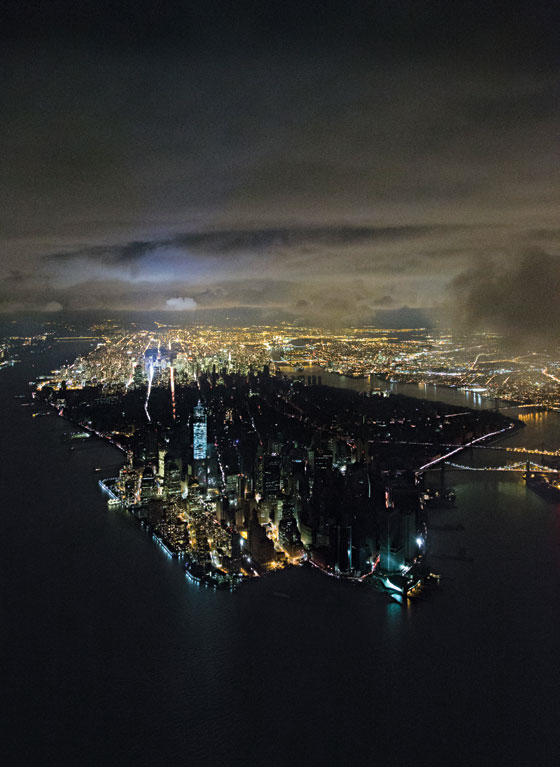Image of the Day: Aerial view of blackout on Manhattan Island after Hurricane Sandy
By John Homans
4 November 2012 The calm before the storm was much too calm, which should have been a clue. Forecasters had been talking about a potential Halloween hurricane—the Frankenstorm was its headline-ready name—for two weeks. They thought it might be bigger than the hurricane of 1938; its barometric pressure was already a few ticks lower. The twist about this one, endlessly dissected, was that it was actually going to be two storms: Sandy would head north and encounter another weather system coming down from the northeast, a bank shot that would send the storm directly at New Jersey and a surge straight into the harbor, which is a natural funnel—New York’s own perfect storm. The subway was shut down early on Sunday night, more than 24 hours before expected landfall, and Mayor Bloomberg, a reborn weather alarmist after the 2010 blizzard, canceled school and told people to read a good book. Monday felt like Sunday on Seconal. For entertainment, we had breathless newscasters standing in puddles in their wet-weather gear, heralding the Storm of the Century that no one believed would really happen. “What preparations are you making?” asked an out-of-towner. “We have a lot of tea lights!” said the New Yorker, suggesting that anything more might be overkill. Outside, there was a gusting breeze, pulsing sheets of blowing spray. Inside was a flashlight, maybe some tuna and sardines, a disaster pantry left over, unused, from Irene. And then it started. It hit New York first out in the boroughs, a fourteen-foot surge pushing into the swampy lowlands of Staten Island, floating houses off their foundations, flooding people’s cars before they realized they were in danger. At Breezy Point, a fire had started at seven with the tide rising. In Red Hook, the water had crested the bank that afternoon, making no exceptions, swamping the housing projects and the Fairway and the artisans’ studios with six feet of water. Finally, Manhattan itself began to be submerged. Water poured over the esplanades that are one of Bloomberg’s most impressive legacies, swamping bodegas on the East Side, lapping the High Line on the West Side. At ground zero, 30 feet of water poured into the famous bathtub—submerging our last disaster. But that was only the beginning. Because then, the lights went out. […]

There was a zero increase in storable food / emergency food sales before Hurricane Sandy. And even now, afterwards, only a tiny tick upwards.
I can only explain this as cognitive dissonance. Hundreds of millions have watched the news about the storm, food shortages, gas shortages and still think "it can't happen here". Very strange behavior.
Climate change is here to stay and it only promises to be significantly worse (for everyone). They're now expecting to lose all the ice in the Arctic in just 3 – 7 years, something I follow pretty closely.
This will cause massive storms as weather patterns shift dramatically, a huge increase in precipitation (rain and snow) and even worse droughts in the Southwest. The jet stream is being hugely impacted by this.
Also spotted where the East Coast water temperatures as as high as 5 degrees already above normal.
These aren't "Frankenstorms", they're the new normal, climate change here and now, and we are witnessing America's new refugees.
~Survival Acres~